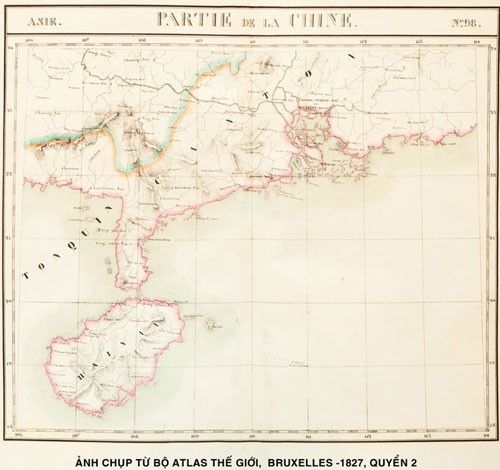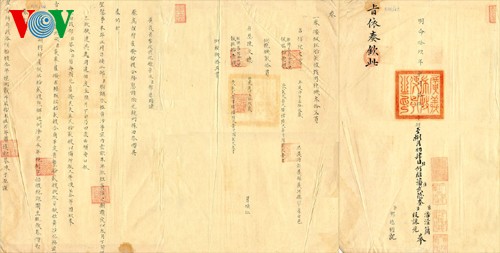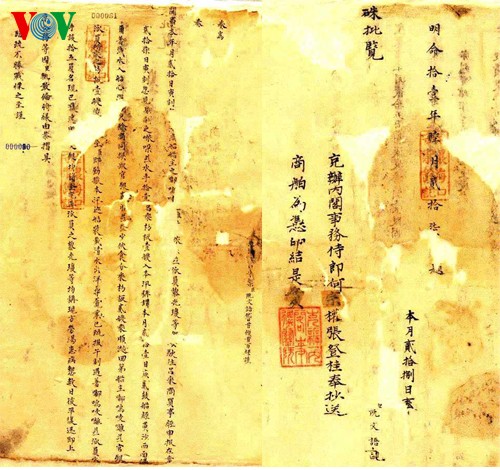(VOVworld) – Vietnamese and others around the world have strongly denounced China’s violation of Vietnam’s sovereignty by placing oil rig Haiyang 981 within Vietnam’s exclusive economic zone and continental shelf. In addition to violating the 1982 UN Convention on the Law of the Sea and regulations on the rights of coastal countries, China has used force in the sea and falsely accused Vietnam of provoking tensions. VOV will run a series of articles analyzing territorial sovereignty under international law, previous territorial disputes and resolutions around the world, and Vietnam’s indisputable historical and legal evidence concerning ownership of the Hoang Sa (Paracel) and Truong Sa (Spratly) archipelagos.

A copy from the World Atlas, Brussels - 1827, volume 2
|
Territorial sovereignty disputes in many places around the world have been resolved by looking at actual, uninterrupted, and peaceful occupation and state governance.
Actual occupation – the most important principle in confirming sovereignty
The principle of actual occupation was mentioned in the resolution of the Berlin conference on Africa in 1885 with the participation of 13 European countries and the US. The resolution defined that a nation is acknowledged the owner of a new land if it is the first occupier and then performs actions such as reporting its occupation to other nations and appropriately maintaining its power in the occupied land. The International Lausanne Law Academy confirmed this principle in 1888 and got it recognized by other countries. At present, there is no ownerless territory in the world, and the principle has remained valid and has been applied by international arbitrators.
One example is the dispute between the UK and France over the Minquier and Ecrehous archipelagos in 1950. The court ruled in favor of the UK because the UK could prove its sovereignty over and ownership of the archipelagos for centuries. Another example is the Clipperton coral island in the Pacific, 500 nautical miles from Mexico’s southwestern coast. The Mexicans came here in 1892 but did not continuously occupy the island. After World War II the French built a meteorology center here and continuously exploited the island until the present. Although the island is 10,000 nautical miles from France, the international court ruled that the island belongs to France because France was the first nation to establish sovereignty over the island.
Back to the case of Vietnam. Bordering the East Sea, Vietnam has a long coast line and thousands of coastal and offshore islands and archipelagos including Hoang Sa and Truong Sa archipelagos. Vietnam was the first nation to discover, possess, and establish sovereignty over the two archipelagos, which it has occupied peacefully and uninterruptedly since the 17th century. Vietnam has never abandoned its sovereignty over the two archipelagos even when China used force to invade and occupy Hoang Sa in 1974.
Solid legal and historical basis
Vietnam has always exercised an actual, peaceful, and continuous possession of Hoang Sa and Truong Sa. Historical documents record the establishment of the Hoang Sa flotilla and the Northern Marine Force by the Nguyen Lords to exploit sea resources and plant markers of national sovereignty in 1816, 1834, 1835, and 1836.

An imperial archives of the Nguyen regime in 1947 talks about annual military journeys to Hoang Sa to explore marine routes and resources. |
Historical confirmation of Vietnam’s sovereignty over Hoang Sa and Truong Sa archipelagos is based on state documents. Official documents from different periods, including The Chronicles of Vietnam, Vietnamese Administrative Records, the imperial archives of the Nguyen dynasty, and the Geography of Unified Vietnam all confirm that Hoang Sa belonged to Vietnam’s sea territory at the time.

An imperial archives of the Nguyen regime in 1830 reported about the rescue of a French merchant boat sinking in Hoang Sa |
In addition to these Vietnamese documents, Vietnam’s sovereignty over Hoang Sa and Truong Sa is established by certain historical documents of China and Western countries. China’s claims of sovereignty over Hoang Sa and Truong Sa, on the other hand, don’t satisfy the criteria of actual, peaceful occupation and state management. China’s system of geographical names isn’t based on historical factors and the collection of geographical names is not supported by original documents. In 1909, long after Vietnam, China claimed sovereignty over Xisha, its name for the Hoang Sa archipelago. Significantly, before China’s illegal occupation of Hoang Sa, among China’s official history books, 200 books made no mention that Hoang Sa archipelago belonged to China.
Moreover, China’s documents are equivocal. Many ancient Chinese geography documents specify that the southernmost end of China’s territory is Hainan Island. This is clearly stated in the Qiong Zhou and Guangdong Monograph Books of 1731, the Unified Imperial Geographical Map issued in 1894, and China’s Geography Book Collection published in 1906.
Vietnam is determined to use all evidentical, peaceful means to defend its territorial integrity.
It is clear that according to international law, precedence in settling territorial disputes and historical evidence, China has no grounds for claiming sovereignty over the Hoang Sa and Truong Sa archipelagos.
What Vietnam has been doing conforms to international law. Vietnam has taken the first steps in invoking international law. Vietnam is peacefully negotiating, citing evidence, involving international regulations to bring about a common perception around the world and rally the would community to support Vietnam’s just struggle for its territorial integrity.